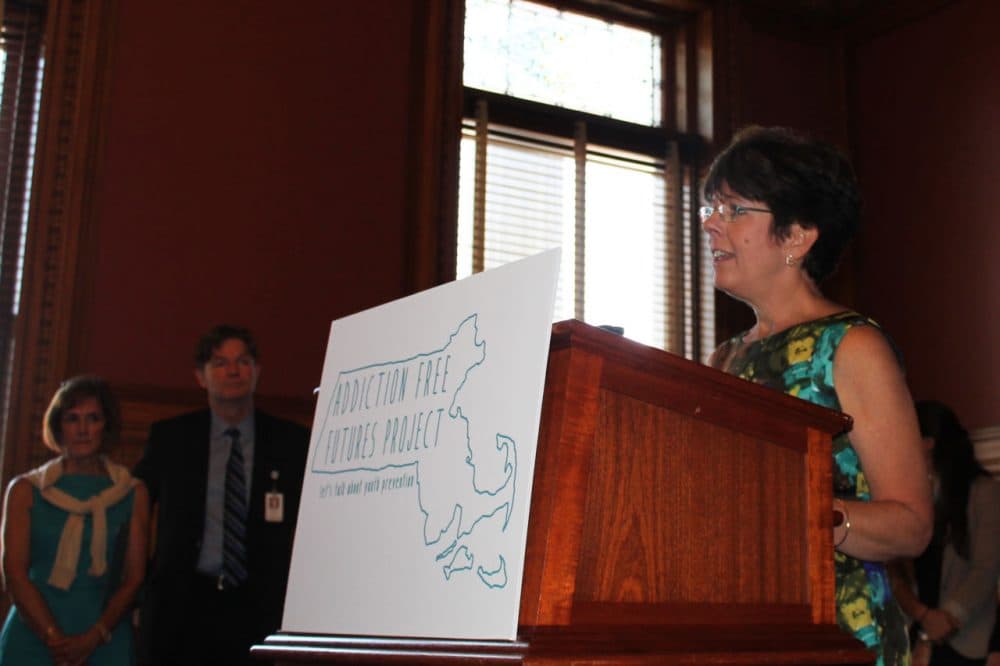Advertisement
Committee OKs Bill That Aims To Screen Students For Substance Abuse

Sophia Mercado, who battled addiction as a high school student, said Thursday that she felt no one at her public school understood the signs of addiction or how to help a young person struggling with substance abuse.
"Being a high school student battling addiction is hard and scary," said the 18-year-old Mercado, who now attends a recovery high school in Boston. "There are students like me all over the state of Massachusetts struggling with drugs and alcohol who would benefit from having more support in their schools."
Mercado was one of about 60 people gathered Thursday morning for the launch of the Addiction Free Futures Project, which aims to address drug addiction by expanding access to prevention and early intervention programs for teens.
"The earlier we can get to kids, the better off the trajectory is for that child," Massachusetts Society for the Prevention of Cruelty to Children CEO Mary McGeown said. "If we can help delay that first drink or that first use of marijuana, we know it makes a real difference in that kid's life."
The Addiction Free Futures Project is pressing for passage of a bill (H 1796) that would add SBIRT — Screening, Brief Intervention and Referral to Treatment — to the list of health screenings conducted in public schools. The bill calls for screenings "at least once annually in grades 8 or 9, and 11."
The Mental Health and Substance Abuse Committee heard testimony in support of the bill Thursday afternoon before reporting the bill favorably.
"We think, given the epidemic that we have here in Massachusetts, this is truly something we can do that is common sense," committee co-chair Sen. Jennifer Flanagan (D-Leominster) said at the Addiction Free Futures Project launch. "It is common sense to start talking to people, to start talking to teens whether they're in middle school, whether they're in high school and really getting the word out there that we care and we want to make sure you live healthy and productive lives."
Advocates said SBIRT is "an evidence-based and cost-effective set of tools that helps identify alcohol or drug use and guides follow-up counseling and treatment if a problem exists."
The screening consists of a short questionnaire to assess the patient's risk of using drugs or alcohol in an unhealthy way, the intervention portion consists of "non-judgemental" conversations about substance use and options for change, and the referral typically involves providing information about services like Alcoholics Anonymous, according to the Department of Public Health Bureau of Substance Abuse Services.
"SBIRT in schools makes a lot of sense, it is a fairly simple procedure to do it and we know it's effective, it reduces substance use both acutely and over the long term," said Dr. John Kelly, a psychologist at Massachusetts General Hospital. "It is also very cost effective. In studies that have been done, roughly for every $1 invested in (SBIRT), we save about $6 in costs in terms of lost productivity, criminal justice involvement and health care costs."
Training school staff in SBIRT practices and implementing such screenings across the state would cost about $2.5 million, MSPCC Project Manager Courtney Chelo said.
"After the initial investment to train school staff and implement the program, it would require much less in the budget to sustain it," she said.
Already, the SBIRT model is used in Gloucester, Hadley, Hudson, Natick, North Andover, Northampton and Wilmington. In those districts since 2012, more than 3,000 students have been screened using SBIRT techniques, according to Jenny Gormley, director of the School Health Institute at Northeastern University.
Of those students, Gormley said, 4 percent were found to be at higher risk for substance abuse and referred to outside providers for treatment. Thirteen percent of students were found to be at lower risk for substance abuse and received brief intervention with the school nurse or counselor. And 83 percent of students were found not to be at risk and received positive reinforcement, Gormley said.
In the districts already using the SBIRT model and if it is expanded statewide, Chelo said, the screening requires parental consent.
"Like with any health screening done at the schools, parents are informed in advance and given the time and ability to opt their child out of the screening," she said.